Jarrow and District Electric Tramways
History
Jarrow and District Electric Tramways were owned and operated by the Jarrow and District Electric Traction Company Limited, which was a subsidiary of the much larger British Electric Traction Company Ltd (BETCo), a concern which at its zenith either owned, part-owned or leased almost 50 tramway concerns across the British Isles.
In the late 1890s, the BETCo was aggressively purchasing horse and steam-operated tramways across the British Isles with the intention of converting them to electric traction, as well as promoting schemes for completely new electric tramways. In late 1897, the BETCo entered into a provisional agreement with the Gateshead and District Tramways Company to purchase the latter and extend it, providing it was successful in securing powers to convert the existing steam tramway to electric traction. The BETCo had in fact grand plans to build a tramway network south of the Tyne, stretching from Gateshead eastwards through Hebburn and Jarrow to South Shields, then south to Sunderland.
In 1899, the BETCo acquired both the G&DTCo, and the operator (lessee) of South Shields Corporation's horse tramway, the South Shields Tramway & Carriage Company Limited. Although this was followed on the 17th December 1901 by powers to construct tramways in Jarrow, things to the east and west of the town were destined not to go to plan. To the west, Hebburn Urban District Council opposed all attempts to promote tramways within its area — ostensibly to build its own system, but having seen off the competition, no doubt at considerable expense, then proceeded to do nothing — whilst to the east, it eventually became clear that South Shields Corporation were determined to build and operate its own municipal tramway. These developments effectively reduced the BETCo's hopes of building an interconnected tramway network to the east of Gateshead to just a small, isolated system in Jarrow, one which the company was now less than enthusiastic to construct.
Matters nevertheless proceeded, albeit slowly, the J&DETCo being registered on the 30th September 1903. Although work commenced in 1904 on what was perhaps the most challenging aspect of the scheme, a new bridge on a private right of way across the River Don, progress was slow, hardly helped by a deteriorating relationship between the company and the corporation. The main bone of contention was the company's decision not to build a line along Albert Rd, which would have formed the connecting line to the west in the BETCo's grand scheme, but which was of course now of no use, and would probably have been uneconomic to operate as a branch line; the corporation however, became fixated on trying to force the company's hand, trying many avenues, including the Board of Trade, all unsuccessfully.
The first section of the J&DETCo's standard-gauge tramway finally opened on the 29th November 1906, the remainder following on the 21st December 1906, the system totalling just 2.54 miles. The tramway served a heavily industrialised area along the south bank of the Tyne, running eastwards and southwards from a terminus in Western Rd, before crossing the River Don by the aforementioned bridge, passing through East Jarrow and under four railway bridges serving Tyne Dock, to a terminus at the junction of Slake Terrace and Hudson Street. The tracks and overhead here were connected to those of South Shields Corporation Tramways. Although through-running was eventually agreed, it was an on-off affair, with various fall-outs over money, the travelling public suffering as a consequence. In the 1920s, inter-running was restored for around 5 years, cars of the J&DETCo travelling through to the Pier Head, and those of the corporation running through to Jarrow.
Bus services in the area were first introduced in 1913 by the J&DETCo's much larger sister concern to the west, the G&DTCo. The following year, both the J&DETCo and the G&DTCo, along with the Tynemouth and District Electric Traction Company Limited were formally placed under the control of the Northern General Transport Company, which had been set up by the BETCo to consolidate all its transport interests in the area.
As with many tramways, the Great War brought challenges to the J&DETCo, with severe shortages of men, extremely heavy loadings (due to war work), and an inability to resource maintenance, either from a manpower or materials perspective, coupled with restrictions on purchasing new track and tramcars. As a result, the tramway emerged from the conflict in very run-down condition, and was soon plunged into a world of post-war inflation and economic hardship.
Although the J&DETCo had always made a modest profit, the harsh economic climate and intense bus competition of the 1920s was another matter entirely. The writing on the wall was plain to see when in 1926 the NGTCo started a bus service between Gateshead and South Shields, which followed the line of the tramway, the parent company effectively competing directly with its subsidiary. With track renewals in the offing and an aged tramcar fleet, the J&DETCo sought powers to abandon the tramway in 1929. The last tram ran on the 30th June 1929, being replaced by bus services operated by the J&DETCo and the NGTCo.
Uniforms
Jarrow and District Electric Traction Co tramcar crews were issued with the familiar and largely regulation BETCo uniform. Although jackets appeared to vary somewhat between BETCo systems, as well as across the decades, the cap badges, collar designations and buttons invariably followed a standard pattern.
Conductors and motormen were issued with double-breasted, lancer-style tunics with five pairs of buttons (narrowing from top to bottom, and of the standard BETCo pattern — see link), and stand-up collars. The latter carried an employee number on the bearer's left-hand side — in individual brass numerals — and system initials on the right-hand side, in individual brass letters. Although the latter cannot be made out with certainty on surviving photographs, by analogy with other BETCo systems, they were almost certainly either 'J D E T' or 'J D T'. The tensioned-crown peaked caps carried the standard brass BETCo ‘Magnet & Wheel’ cap badge (see below), with an employee number worn below.
Tramcar crews were also issued with long, double-breasted greatcoats with five pairs of buttons and high, fold-over collars; other than the buttons, these garments appear to have been devoid of insignia.
Inspectors wore single-breasted jackets edged in material of a finer quality than the main jacket, without hidden buttons (most likely a hook and eye arrangement), two waist pockets, two breast pockets and stand-up collars; the latter carried the designation 'Inspector' in embroidered script lettering. The caps were similar to those worn by tramcar staff, but bearing an embroidered script-lettering grade badge —'Inspector' — on a brocade hat band, with the standard 'Magnet & Wheel' cap badge worn above.
In common with most UK tramway operators, the J&DETCo employed female staff (as conductresses) during the Great War, to replace men lost to the armed services. Unfortunately, only a single photograph of one of these ladies appears to have survived (see below), and this only reveals the sketchiest of uniform details. The lady in question is wearing a long, double-breasted coat with lapels, seemingly devoid of insignia, and a light coloured scarf. Headgear comprised a baggy motor cap with a stiff glossy peak, which almost certainly bore the standard BETCo 'Magnet & Wheel' cap badge. The cap, coat and scarf are very reminiscent of the J&DETCo's near neighbour and sister company — Gateshead and District Tramways Company — so in all likelihood, the J&DETCo also issued its ladies with single-breasted, tailored jackets with five buttons, hip pockets, lapels, and a belt with two buttons, all without badges of any kind (see link).
Further reading
For a history of Jarrow's tramway system see: 'The Tramways of Jarrow and South Shields' by George S Hearse; published by the author (1971).
Images
Motormen and conductors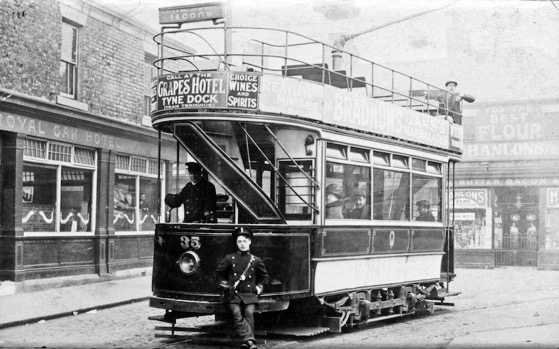
A conductor and motorman pose with Tramcar No 35 outside the Royal Oak Hotel in Jarrow circa 1910. Tramcar No 35 was part of the Gateshead & District Tramways Company fleet (another local BETCo subsidiary) and was initially borrowed by the J&DETCo and then purchased in 1911, becoming J&DET No 10. Image kindly supplied by Beamish Museum Limited (see link), image copyright Beamish Museum Limited.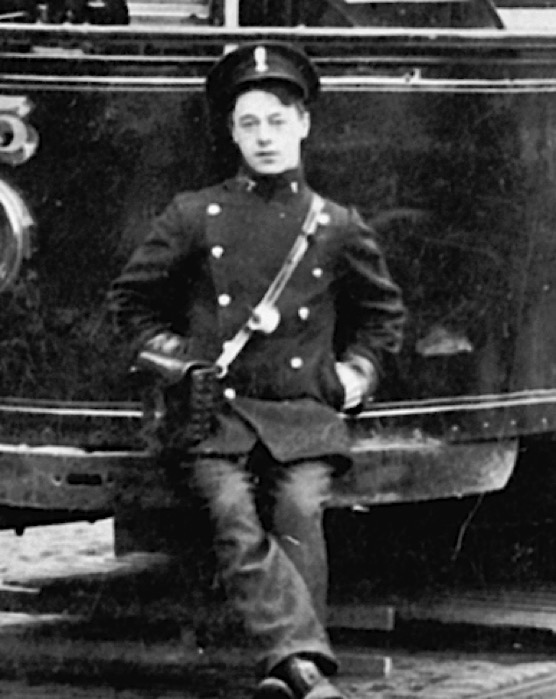
A blow-up of the above photo showing the rather nonchalant-looking conductor. He is wearing the standard BETCo 'Magnet & Wheel' cap badge above an employee number. His left-hand collar also carries an employee number, with the right-hand side bearing system initials, of which only the 'T' can be seen. 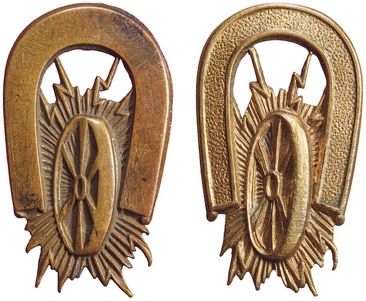
British Electric Traction Company ‘Magnet & Wheel’ cap badges — brass. The precise relationship between the two patterns is unclear. Author's Collection.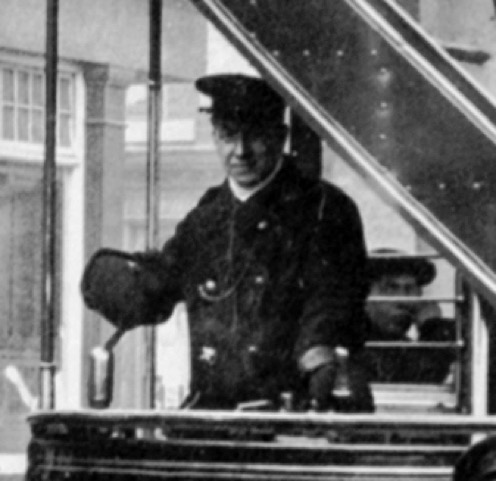
Another blow-up of the above photo, this time showing the motorman. He is wearing large mitts, an absolutely necessity one would imagine, for driving an open platform tram in northeast winters.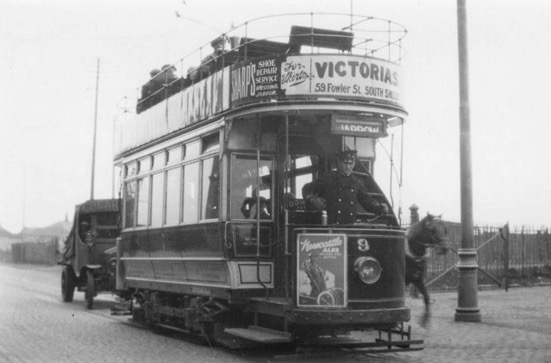
Tramcar No 9 in Swinburne Street circa 1927. With thanks to Malcolm Fraser.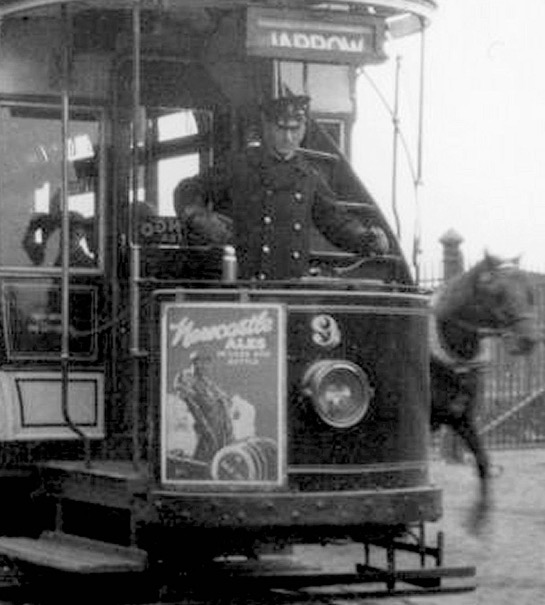
A blow-up of the above photo showing the motorman, in double-breasted greatcoat and with mitts.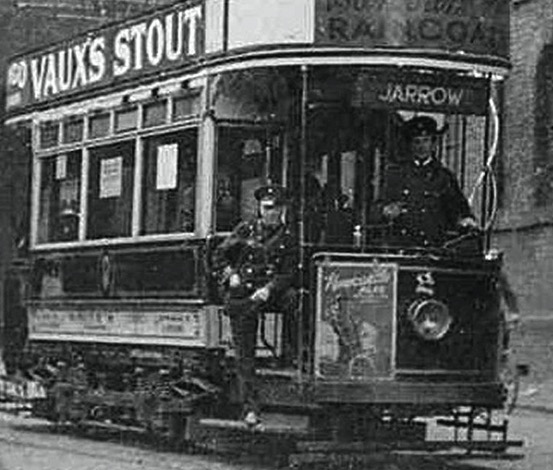
A conductor (left) in lancer-style tunic, and motorman (right), on the platform of Tramcar No 2 at Tyne Dock circa 1928. With thanks to Malcolm Fraser.
Senior staff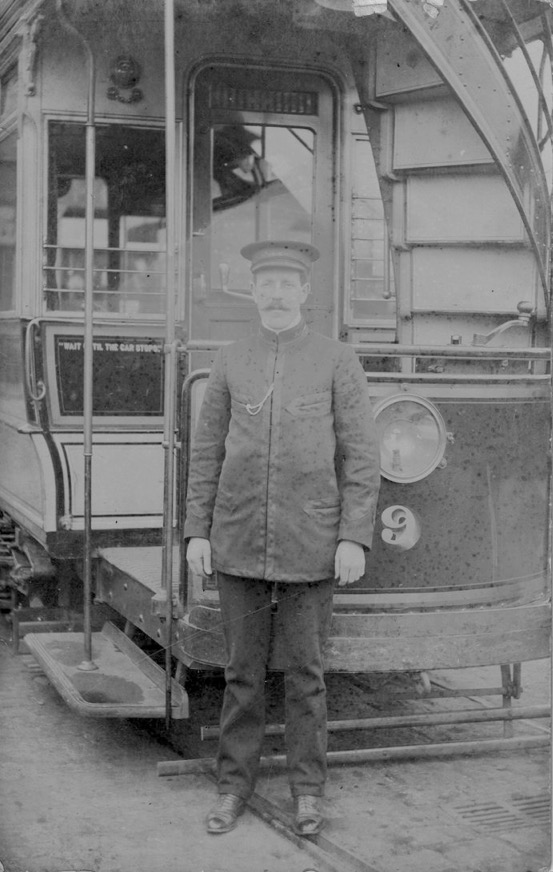
A Jarrow and District Electric Tramways inspector with Tramcar No 9. This car was was used as a demonstrator by the BETCo from 1902, arriving in Jarrow in 1907, which in view of the relatively good condition of the vehicle, is probably when the photo was taken. The inspector is wearing a fairly typical BETCo senior staff uniform. Authors Collection.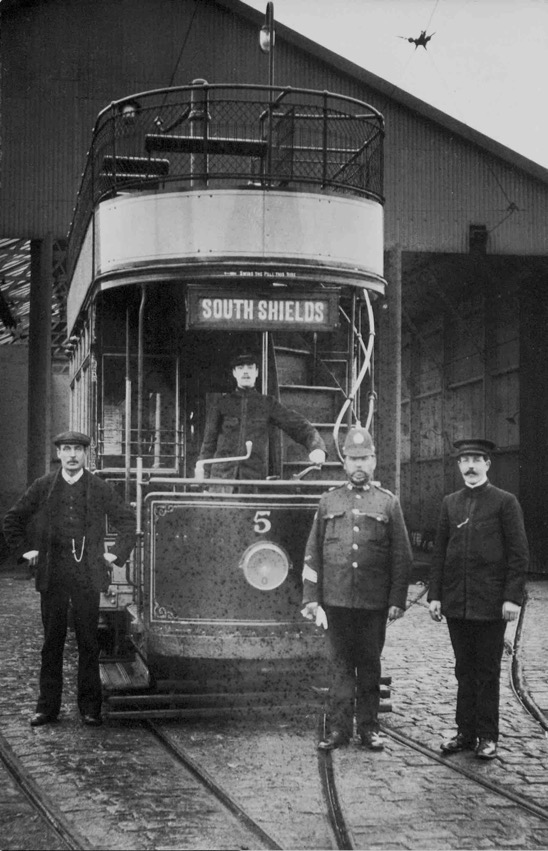
Two inspectors (one at the tram controls and the other standing at the right) pose with Tramcar No 5 outside Swinburne St depot. Although the image is undated, Tram No 5 was exchanged in 1908 with the Gravesend and Northfleet Electric Tramways — another BETCo subsidiary — so it is possible that the photo was taken to commemorate its departure, given that it has definitely seen some use. Photo courtesy of the John Carlson Collection.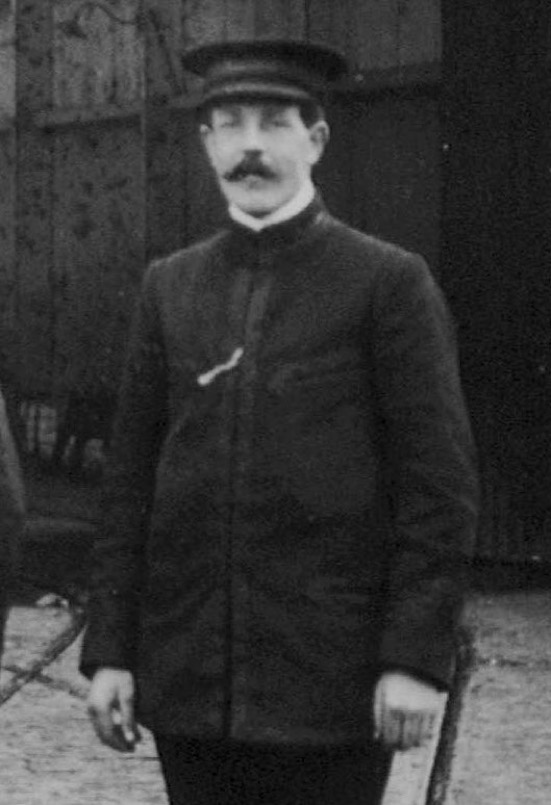
A blow-up of the above photo showing one of the inspectors, who appears to be the same man as in the photo of No 9 above.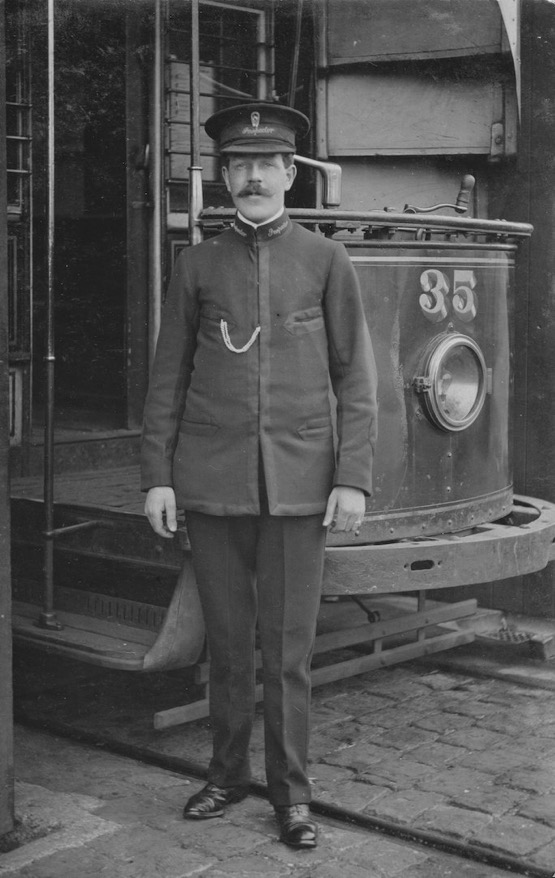
A Jarrow and District Electric Tramways inspector, almost certainly the same man as pictured in the preceding photographs, but this time with Tramcar No 35. This car was loaned from the neighbouring BETCo system at Gateshead between 1911 and 1914, so the photograph must have been taken during this period. Authors Collection.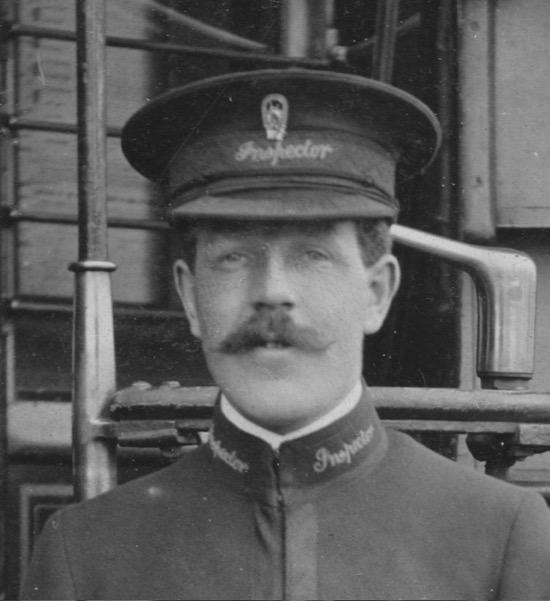
An enlargement of the above photograph, showing details of the collar and cap insignia. The 'Magnet & Wheel' cap badge is the variant with the coarse finish to the magnet.
Female staff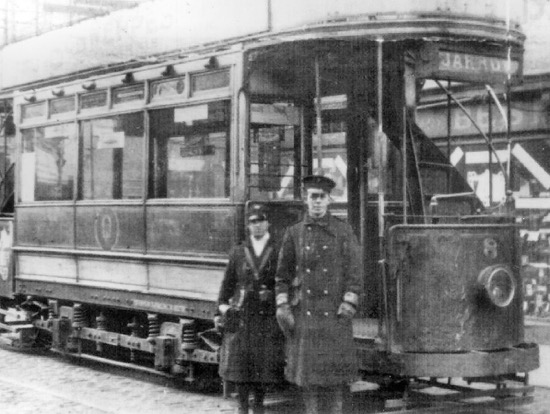
A rather poor photograph, but the only one I'm aware of that depicts a Jarrow and District Electric Tramways Company Great War conductress. The conductress and motorman are pictured with Tramcar No 8 in Western Rd circa 1916. With thanks to Malcolm Fraser.